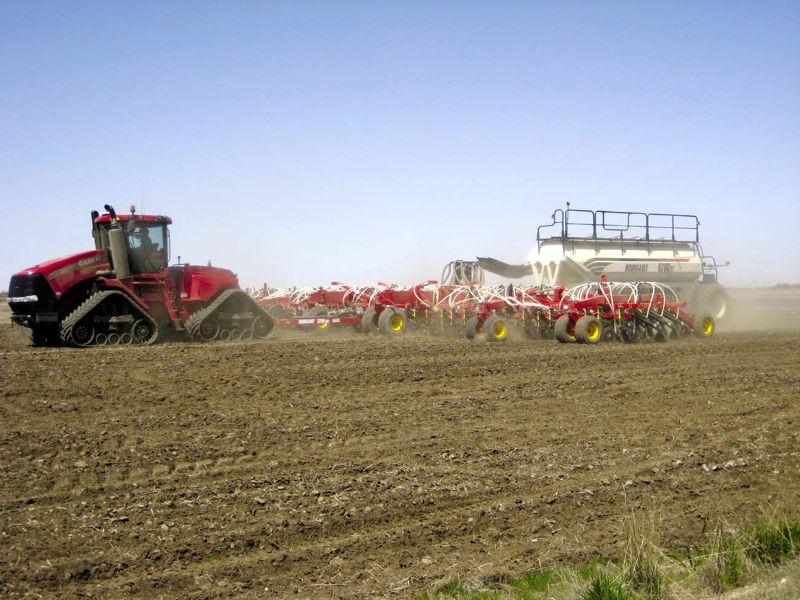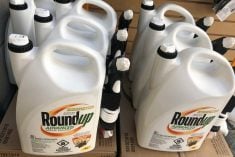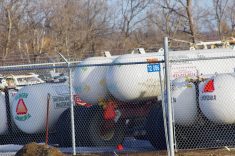[Updated: April 9, 2017] When Dr. Mario Tenuta braved icy roads to drive from his home in Winnipeg to Weyburn, Sask., to speak at the Indian Head Agricultural Research Foundation (IHARF) Soil and Crop Management Seminar, he wasn’t planning to make many friends. The University of Manitoba soil scientist had come to make farmers aware that government policies designed to curb climate change are going to change the way we farm. He set the tone for his presentation by saying, “A lot of the things I’m going to say — you’re going to think I’m full of B.S.”
Read Also

Cancer agency reclassifies another herbicide ‘probably carcinogenic’
The WHO’s cancer research agency has now put atrazine, a herbicide well known to corn growers, in the same potential-hazard category where the agency put glyphosate.
It was about -20 C in Weyburn the day of the IHARF seminar. “A day like today, you actually wouldn’t mind if it was a few degrees warmer,” Tenuta said. Whether or not we would like a little more heat in Saskatchewan in February, Canada has made some international commitments to reduce our greenhouse gas (GHG) emissions. Our federal government has committed to lowering emissions to 30 per cent below 2005 levels by 2030.
Canada has set and missed targets like this before. However, with a new Liberal government that’s already announced a carbon tax, this time may be different.
Tenuta came to explain to the IHARF audience how environmental policy changes might impact Prairie agriculture.
Agriculture and GHG
“Agriculture makes up about eight per cent of the GHG emissions in Canada,” Tenuta said. This doesn’t include carbon dioxide emissions from our use of fuel (diesel, gasoline or natural gas). It also doesn’t include any carbon sequestered in the soil. This is based on definitions set out by the Intergovernmental Panel on Climate Change.
The federal government also calculates emissions by “economic sector” based on some different definitions. When economists adjust the numbers this way, “if we include emissions from transportation, from your tractor, pesticides, and so forth, it now jumps up to 10 per cent, in terms of all agricultural activity,” Tenuta said.
For policy-makers looking for ways to reduce Canadian emissions, a sector contributing 10 per cent of the total makes a nice target.
Information about agriculture’s GHG emissions is available on the Agriculture and Agri-Food Canada website. AAFC lists out the three main gases emitted by agriculture:
- Carbon dioxide (CO2), which is released during soil cultivation;
- Methane (CH4), which is associated with cattle and livestock manure; and,
- Nitrous oxide (N2O), which comes from using fertilizer and manure.
According to the AAFC website, to add up emissions of the three gasses, you need to convert everything to CO2 equivalents. A tonne of N2O is equivalent to 298 tonnes of CO2. This is because N2O is a lot more effective at trapping heat.
Carbon dioxide released during cultivation, Tenuta explained, hasn’t changed much since 2005. The other two components make up a much larger component of our emissions. “When you hear about imposing potential changes in agriculture, they’re actually focused on methane and nitrous oxide emissions.”
Tenuta said government policy will likely focus on two areas: reducing methane in cattle and dairy production, and the use of nitrogen in food production.
Tenuta focused his talk on how nitrogen use might be impacted by future policy rather than the methane aspect — presumably because he is a soil scientist, and most of the IHARF participants were grain and oilseed farmers.
What about carbon credits?
Before he moved on to talk about nitrogen use, Tenuta paused to talk about carbon credits.
He pointed out that if you’ve been zero tilling since 2005, you haven’t changed your emissions. Your carbon was captured before the benchmark year, so you have minimal arguments for getting a credit.
Some participants asked about getting credit for increasing yields, or sequestering carbon in straw. Tenuta said, “the wheat or the canola eventually gets decomposed back to CO2. It never gets sequestered.”
Right now, he said, no international agreement includes carbon sequestration. While Canada might push to include it, Tenuta described the situation as a “hot potato.” Canadian carbon emissions from the forestry sector fluctuate widely from year to year — driven by forest fires. Including forest fire emissions in our GHG commitment would make it difficult for Canada to meet targets.
“At a political level, Canada probably will give you carbon credits, to make sure you’re happy,” Tenuta speculated, “but that doesn’t have a bearing on international obligations.”
Tenuta is not a fan of carbon credits for sequestration. If you come out of zero till, “you quickly will lose your carbon as you disrupt the soil.” If you make a management decision to till to control weeds or deal with moisture, “does that mean somebody has to give back that carbon credit?”
Tenuta believes grain farmers can make the most progress toward lowering GHG emissions by lowering emissions from nitrous oxide.
Nitrous oxide emissions
We’re emitting nitrous oxide when we use nitrogen as fertilizer.
At a long-term farm site south of Winnipeg, the University of Manitoba monitors GHG emissions. (Tenuta says very few places in the world do this.) Every time they apply fertilizer to grow crops on the site, they can measure N2O emissions from the land. When they grow crops that biologically fix nitrogen (like soybeans), they can’t measure any N2O emissions.
“This is our conundrum: we need nitrogen fertilizer to produce most of our crops,” Tenuta said.
What could this cost?
The Trudeau government has announced a tax on carbon of $30 per tonne by 2018 and $50 per tonne by 2022.
Tenuta has estimated the potential costs of various levels of a carbon tax on fertilizer use. He’s considered two components: first, a charge to farmers for the emissions caused by using nitrogen fertilizer; also, a charge to fertilizer manufacturers for emissions from making the product.
Because fertilizer prices fluctuate so much, Tenuta expects a potential tax on fertilizer manufacturer (which would likely be passed on to farmers), to be the less distressing component.
“Don’t so much worry about the carbon tax on the manufacturer’s end, what you need to worry about is, eventually, a potential carbon tax on using the fertilizer on your soil.”
It’s not impossible to imagine a tax on GHGs emitted through nitrogen use. Tenuta has estimated the potential costs.
To do this math, Tenuta assumed:
- Two per cent of applied nitrogen is emitted as N2O;
- Application rates of 100 kg of N/hectare, (about 89 pounds per acre).
After calculating estimated emissions and converting the carbon tax to N2O equivalents, he’s calculated that a tax could reach $57.39 per hectare ($19.08 per acre) with a $50 carbon tax. (If you’re trying to do the math at home, Tenuta assumes we’re emitting 0.002 tonnes of N per hectare. He converts that to the N2O equivalent, then to the CO2 equivalent. Then he multiplies that by the per tonne price of the tax. I’ve converted his results to dollars per acre.)
Tenuta estimates that a $30 per tonne level of carbon tax is equivalent to a tax of $11.45 per acre on fertilizer use, and $2.49* per acre on fertilizer manufacture.
“My objective as a researcher/professor is to help you adjust so we never have to get to this point of being charged for emissions. That’s my goal, is to help you avoid that.”
If the government sees the agriculture sector reducing emissions, Tenuta speculated, a tax like this may never be implemented — the government wouldn’t see a need to use a tax to influence our behavior. “Voluntarily, let’s use the 4Rs: right rate, source, placement and timing.”
As well as general stewardship, Tenuta recommended using stabilized nitrogen and controlled release nitrogen products to reduce emissions. “In general we find the nitrification inhibitors and ESN reduce emissions by about a third,” he said.
“We have new technology. And 20 years from now you’re going to have even fancier fertilizer.”
Didn’t go over well
Of course there were a lot of comments, most of them not too happy.
One farmer asked how we can possibly pass these taxes on to consumers. Tenuta said farmers will find a way to stay profitable, and once there’s an opportunity in the form a carbon tax, companies will invest to develop new products along the lines of stabilized nitrogen to help farmers reduce emissions.
“I don’t think there’s doom and gloom,” he said.
“You’re not farming the way you did 25 years ago. It’s going to change.”
It already has. Tenuta has done the math. “Every year we use more fertilizer.” Over the last two decades, fertilizer use has increased by about one to 1.5 pounds per year acre for major field crops.
We can’t keep increasing our nitrogen use and also lower emissions. “Our immediate challenge as farmers and an industry is to produce more food with the same amount of nitrogen or less. Nitrogen use efficiency in our system has to improve.”
Nobody likes a tax, especially not a tax that could damage our ability to compete internationally, and can’t be passed on to our buyers.
Tenuta didn’t expect the crowd to like his talk. When he put up his final slide, the audience started to laugh, and Tenuta laughed too. The slide title? “What pisses you off the most?”
These were our options, laid out on Tenuta’s slide:
- “no-till doesn’t count much for credits;
- increased yields don’t count for credits;
- possibly paying more for fuel;
- possibly paying for N2O emissions from soil;
- possible restrictions on N fertilizer use;
- not gonna be easy to reduce N2O emissions; and,
- university researchers doing GHG research.”
If we’re going to remain profitable and adapt to the changes coming in the future, we’re all going to need to keep that sense of humour intact.
*This number was changed on April 9, 2017, to reflect errors that were included in previous versions.
















